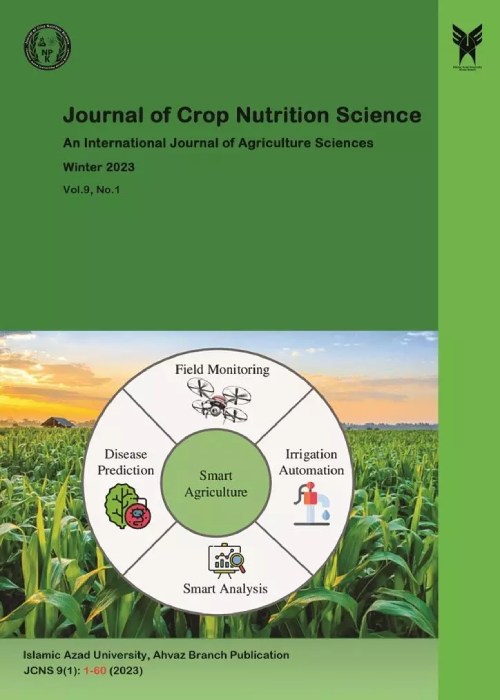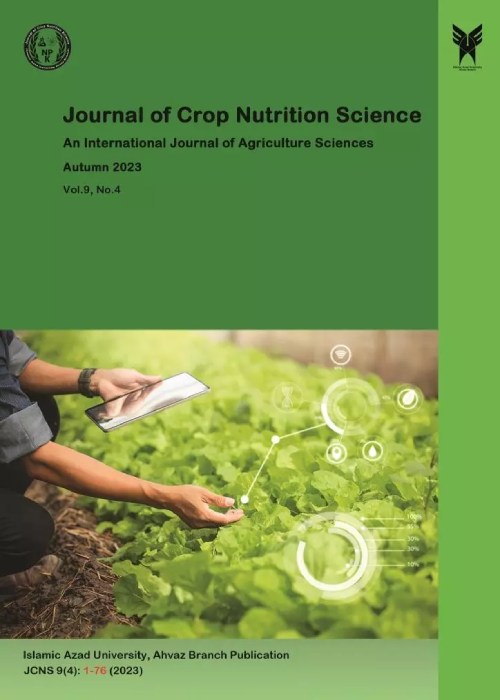فهرست مطالب

Journal of Crop Nutrition Science
Volume:9 Issue: 1, Winter 2023
- تاریخ انتشار: 1402/01/07
- تعداد عناوین: 6
-
Pages 1-20BACKGROUNDRapeseed is a valuable oil crop due to its high nutritious value and ample oil content. Water deficit is one of the crucial limiting factors which reduce crop growth and productivity.OBJECTIVESThe present study aimed to evaluate rapeseed cultivars in the irrigation cut-off conditions in the final stage of reproductive growth (pod formation until full maturity) and planting date delay in selecting the best cultivars for recommendation in autumn rapeseed planting.METHODSThis experiment was implemented in two crop years of 2015-2016 and 2016-2017 as a factorial split-plot in the form of a randomized complete block design with three replications in Karaj region, Iran. In the present study, irrigation in two levels, including well-watered irrigation and irrigation cut-off from the sowing and pod formation stages in two levels, including September 27 and October 27 as the main plot and four winter rapeseed cultivars, including Tassilo, Elvise, Neptune and Okapi were placed in subplots.RESULTThe highest content of chlorophyll in both planting dates (September 27 and October 27, respectively, with values of 1.59 and 1.88 mg.g-1 Fw) and under normal irrigation conditions belonged to Elvise cultivar. Irrigation cut-off reduced relative water content of leaves and increased leaf proline, soluble protein content and soluble carbohydrate content. Elvise and Neptune cultivars had the highest seed yield under normal irrigation conditions with 3346 and 3220 kg.ha-1, respectively, and under irrigation cut-off conditions, with a mean of 3211 and 3081 kg.ha-1, respectively. According to the stress tolerance index (STI), Elvise cultivar was identified as the most tolerant cultivar under dehydration stress in pod formation stage.CONCLUSIONElvise cultivar can be recommended as a suitable cultivar for planting in areas similar to the experimental area where moisture stress is likely to occur in the late stages of growth due to its yield indices in drought stress and non-stress conditions highest seed yield.Keywords: Canola, Irrigation, Seed yield, Soluble protein, Sowing date
-
Pages 21-32BACKGROUNDChickpea is the second most important legume with numerous economic and nutraceutical properties. Therefore, chickpea production needs to be increased from the current level.OBJECTIVESConsidering that the amount of nutrients in the seeds of each plant is one of its positive nutritional characteristics, this research was conducted to investigate the role of iron and cytokinin on the increase of iron, zinc and manganese elements.METHODSThis research was conducted in a factorial experiment using randomized complete blocks design (RCBD) with four replications in Grit Agricultural Services Center located in Eastern-North of Khorramabad of lorestan province in 2011-12 and 2012-13 cropping seasons. The treatments consisted of three cultivars: (Hashem, Azad and local mass), four levels of iron application [control (lack of consumption), 5, 10 and 15 ppm] and four levels of cytokinin (6-Benzyl aminopurin) [control (lack of consumption), 5, 10 and 15 ppm].RESULTThe reaction of cultivars regarding the accumulation of iron, zinc and manganese elements in the seed was different compared to iron and cytokinin. The effect of iron and cytokinin was positive on the accumulation of iron in the seed, and the highest amount of iron (with an average of 72.7 mg.kg-1) belonged to the Hashem cultivar and the application of 10 mg.l-1 of iron and 15 mg.l-1 of cytokinin. While with the increase of iron and cytokinin concentration, the amount of zinc and manganese accumulation in the seed decreased and the highest amount of zinc and manganese accumulation was obtained by usage of 5 ppm of iron and cytokinin.CONCLUSIONThe highest seed yield belonged to the local mass with a concentration of 15 mg.l-1 of iron and cytokinin with an average of 179.6 grams per square meter.Keywords: Magnesium, Microelements, Protein, Pulse, Zinc
-
Pages 33-44BACKGROUNDThe implementation of irrigation techniques in order to be more productive than water resources is a scientific approach to reducing water consumption.OBJECTIVESThis research was done with the aim of investigating the effect of different levels of superabsorbent and irrigation management on Cowpea crop production and growth indices in Ahvaz region.METHODSCurrent study was conducted according strip plots based on randomized complete blocks design with three replications during 2019-2020 crop season. The first factor was irrigation includes Furrow full irrigation (control), Fixed alternate furrow irrigation and variable alternate furrow irrigation. The second factor included three levels of super absorbent polymer as non-used super absorbent (control), consumption of 75 and 150 kg.ha-1.RESULTThe results showed that the effect of super absorption was significant on all measured traits including leaf area index, total dry matter, crop growth rate, seed yield, except net photosynthesis rate. The effect of low irrigation was significant on all traits except crop growth rate and net photosynthesis rate. The interaction effect of low irrigation and superabsorbent on all investigated traits was not significant. The highest and lowest in the examined traits were observed in the field with normal irrigation and fixed furrow irrigation, respectively and among the different amounts of superabsorbent, the highest and lowest values in all examined traits except net photosynthesis rate were observed under the application conditions of 150 kg.ha-1 and non use of super absorbent. In general, the results of the experiment showed that different irrigation methods had an effect on all the morphological, physiological and yield characteristics of cowpea.CONCLUSIONThe application of superabsorbent improved the physiological and morphological traits in normal irrigation conditions and in fields with low irrigation, it led to the reduction of the effects of drought stress and the improvement of the damages caused by it, which can be of interest to researchers and farmers.Keywords: dry matter, Growth indices, Morphology, Pulse, Seed yield
-
Pages 45-57BACKGROUNDUsing plant hormones is an effective way to increase potato yield. Some plant hormones, such as gibberellic acid, cytokinin, and auxin, can stimulate the growth of potato roots and leaves, and among their other effects are regulating plant growth and development.OBJECTIVESThis experiment was conducted in order to assess the effect of growth regulator (IAA hormone foliar application) and weed control on growth indices, crop production and morphological traits of the potato cultivars during two crop years in Bardsir region.METHODSThis research was done at the Bardsir agricultural college, Kerman province(Iran) in 2017-2018 cropping seasons. The study was consisted of a split factorial using Randomized Complete Block Design (RCBD) with three replications. The two potato cultivars (Milva and Sante), as the first factor placed in the main plots, and three levels of foliar spraying of indole acetic acid (IAA) hormone (including of non-use, 200 and 400 ppm), and weed control (including of the pre-emergence application of metribuzin herbicide with an amount of 750 g.ha-1, the two-stage application of metribuzin in the form of split [the pre-emergence application (500 g.ha-1) + the post emergence application (250 g.ha-1)], manual weeding and without weed control were factorially as the secondary factor were also placed in sub-plots.RESULTThe results showed that increasing auxin from no consumption to 400 ppm significantly increased dry and fresh weight of potato tuber, tuber diameter, tuber yield, dry biomass and leaf area index. The application of auxin at 400 ppm significantly increased the weed biomass at the time of potato harvest. The highest leaf area index of 3.46 was observed in Milva cultivar when 400 ppm of indole-3-acetic acid was used. Weed control during the two-step application of metribuzin was recorded with an increase ratio of 15 to 39% compared to the control without treatment.CONCLUSIONThe highest yield of potato tuber was obtained under two-step application conditions of metribuzin and 400 ppm auxin at the rate of 38055.33kg.ha-1.Keywords: Growth indices, IAA, leaf area, Tuber yield, Weed control
-
Pages 58-70BACKGROUNDOptimum uses of nutrients is the most important factor in agricultural systems due to limitations of nutrients especially nitrogen.OBJECTIVESCurrent study was done to assess the consumption of different amounts of nitrogen and Nitroxin biological fertilizer on crop production of dual-purpose barley forage.METHODSThis research was conducted in the cropping year of 2013-2014 in Ahvaz city in the form of a split plot using randomized block (RCDB) with three replications. The investigated treatments include the use of pure nitrogen at three levels (including the use of 50, 100 and 150 kg.ha-1) and the use of Nitroxin biofertilizer at three levels (including no use of nitroxin (control), use of 2 and 4 liters per hectare), were placed in the main and sub plots, respectively.RESULTThe results showed that the effect of different amounts of nitrogen fertilizer and nitroxin biofertilizer on leaf area index, dry forage yield, forage protein yield and seed protein percentage were significant. The highest leaf area index at the flowering stage (4.5), dry forage yield (2450.3 kg.ha-1) and forage protein yield (544.9 kg.ha-1) belonged to the treatment of 150 kg N.ha-1. The consumption of higher doses of nitroxin caused a significant increase in the leaf area index at the flowering stage, dry forage yield and forage protein yield, although there was no significant difference between the consumption values of 2 and 4 liters per hectare in terms of these traits.CONCLUSIONThe interaction effect of the treatments on the studied traits were not significant, according to this, under the consumption of larger amounts of nitrogen (up to 150 kg.ha-1) or the use of biological fertilizer at the rate of 2 liters per hectare (considering the lack of significant difference with the consumption of 4 liters per hectare) can achieve quantitative and qualitative yield of forage in dual-purpose barley cultivation.Keywords: Forage yield, leaf area index, Nitroxin, Nutrition, Protein
-
Pages 71-80BACKGROUNDOne of the best management methods to preserve soil quality is the use of biofertilizers and the use of Nano-fertilizers. Nano-fertilizers are the most effective and at the same time the most independent method of fertilizers, which are aimed at reducing the loss of nutrients and increasing the efficiency of fertilizer consumption.OBJECTIVESThis study was aimed to investigate the effect of foliar application of iron Nano chelate and rhizobium bacteria on crop production of pinto bean genotypes.METHODSCurrent research was done according factorial experiment based on randomized completely block design (RCBD) with three replications in Ilam city in 2014. The investigated treatments include rhizobium bacteria at two levels (inoculated and non-inoculated), the foliar application agent of iron Nano-chelate at two levels (no foliar application and foliar application with iron Nano-chelate with a concentration of two per thousand) and pinto bean cultivars (including three cultivars Talash, Khomein and local).RESULTThe simple and reciprocal effects of treatments on seed yield were statistically significant. The average comparison results showed that Khomein had the highest number of pods per plant in the inoculation treatment with Rhizobium bacteria. Also, in the foliar treatment with iron Nano-chelate, Khomein cultivar had the highest number of pods per plant. Using iron Nano-chelate increased the number of pods per plant by increasing the durability of flowers and turning them into pods. Khomein cultivar had the highest seed yield (with an average of 4759 kg.ha-1) in the treatment of inoculation with rhizobium bacteria and foliar application with iron Nano-chelate.CONCLUSIONBased on the results, the use of Khomein cultivar with foliar application, in all cases replace of iron Nano-chelate and inoculation with Rhizobial bacteria can be effective in increasing the yield of pinto beans in the region.Keywords: Foliar application, Micro elements, Nutrition, Pod length, Pulse


